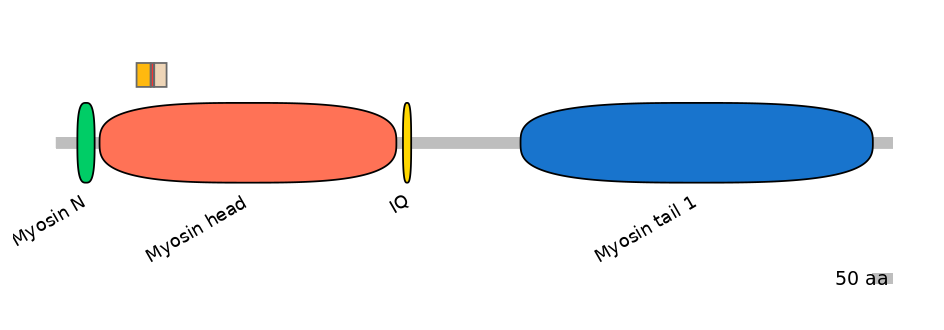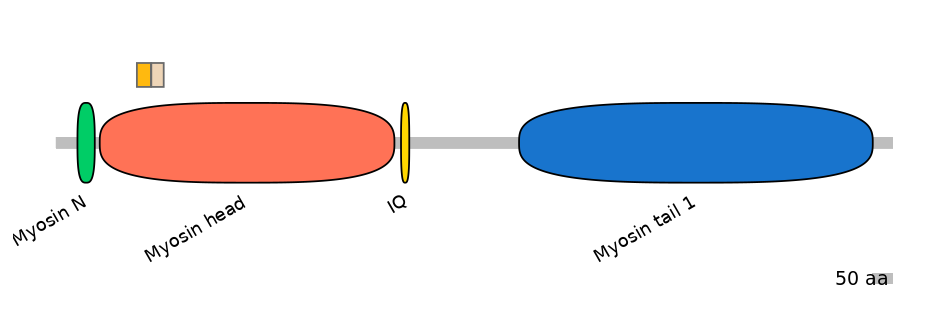HsaEX0040956 @ hg19
Exon Skipping
Gene
ENSG00000105357 | MYH14
Description
myosin, heavy chain 14, non-muscle [Source:HGNC Symbol;Acc:23212]
Coordinates
chr19:50726504-50728934:+
Coord C1 exon
chr19:50726504-50726606
Coord A exon
chr19:50727411-50727434
Coord C2 exon
chr19:50728842-50728934
Length
24 bp
Sequences
Splice sites
3' ss Seq
GTGTCCCGTGACTTCCTCAGGCC
3' ss Score
7.86
5' ss Seq
TATGTGAGT
5' ss Score
5.56
Exon sequences
Seq C1 exon
TGGAGAGTCTGGAGCTGGGAAGACGGAAAACACCAAGAAGGTCATCCAGTACCTCGCCCACGTGGCGTCGTCTCCAAAGGGCAGGAAGGAGCCGGGTGTCCCC
Seq A exon
GCCTCCGTCAGCACCGTGTCTTAT
Seq C2 exon
GGTGAGCTGGAGCGGCAGCTGCTTCAGGCCAACCCCATCCTAGAGGCCTTTGGCAATGCCAAGACAGTGAAGAATGACAACTCCTCCCGATTC
VastDB Features
Vast-tools module Information
Secondary ID
ENSG00000105357_CASSETTE1
Average complexity
S
Mappability confidence:
100%=100=100%
Protein Impact
Alternative protein isoforms (No Ref)
Show PDB structure
Features
Disorder rate (Iupred):
C1=0.265 A=0.000 C2=0.037
Domain overlap (PFAM):
C1:
PF0006316=Myosin_head=FE(15.2=100)
A:
PF0006316=Myosin_head=FE(1.0=100)
C2:
PF0006316=Myosin_head=FE(13.5=100)


Other Inclusion Isoforms:
Associated events
Other assemblies
Conservation
Chicken
(galGal4)
No conservation detected
Chicken
(galGal3)
No conservation detected
Primers PCR
Suggestions for RT-PCR validation
F:
AAGGTCATCCAGTACCTCGCC
R:
AAGGCCTCTAGGATGGGGTTG
Band lengths:
116-140
Functional annotations
There are 5 annotated functions for this event
PMID: 15845534
This event
The authors expressed two alternatively spliced isoforms of NMHC II-C (MYH14) which differ by inclusion/exclusion of eight amino acids in loop 1. Insertion of eight amino acids into the HMM II-C heavy chain increases both actin-activated MgATPase activity and in vitro motility.
PMID: 8509418
Chicken gizzard myosin, that is almost exclusively comprised of the (+)insert iso- form, produces a 2.5-fold higher actin filament velocity in an in vitro motility assay and a 2.0-fold higher myosin ATPase activity than myosin isolated from bovine aorta, which expresses little (+)insert. Importantly, these results in the motility assay were the same after LC17a/LC17b exchange, that is when both gizzard and aorta myosins had the same light chain composition. This suggested that the difference in velocity is due to the heavy chain itself and not LC17.
PMID: 9147986
A baculovirus expression system was used to construct hybrid heavy meromyosins (HMM) as an alternative way to explore the function of this microexon. When the insert was removed, the velocity of chicken gizzard HMM in the in vitro motility assay was reduced by two-fold and the actin-activated myosin ATPase activity was reduced 2.2-fold. Conversely, the velocity and myosin ATPase rates were increased by two-fold when the insert was added into uterine HMM. These results led to the important conclusion that the insert is both necessary and sufficient to explain the two-fold greater rate of actin filament movement and actin-activated myosin ATPase activity produced by the (+)insert SMMHC isoform.
PMID: 9887959
A laser trap was used to characterize the molecular mechanics of the inserted isoform [(+)insert] and of a mutant lacking the insert [(-)insert], which is analogous to the isoform found in tonic muscles. The constructs were expressed in the baculovirus/insect cell system. Unitary displacements (Duni) were similar for both the constructs (approximately 10 nm) but the attachment time (ton) for the (-)insert was two times that of the (+)insert. These data suggest that the insert in the nucleotide-binding loop does not affect the inherent mechanics of the myosin molecule but rather the kinetics of the cross-bridge cycle.
PMID: 10047983
Laser trap was used to characterize the molecular mechanics and kinetics of the inserted isoform ((+)insert) and of a mutant lacking the insert ((-)insert), analogous to the isoform found in tonic muscle. The constructs were expressed as heavy meromyosin using the baculovirus/insect cell system. Unitary displacement (d) was similar for both constructs (approximately 10 nm) but the attachment time (t(on) for the (-)insert was twice as long as for the (+)insert regardless of the [MgATP]. Both the relative average isometric force (Favg(-insert)/Favg(+insert) = 1.1 +/- 0.2 (mean +/- SE) using the in vitro motility mixture assay, and the unitary force (F approximately 1 pN) using the laser trap, showed no difference between the two constructs. However, as under unloaded conditions, t(on) under loaded conditions was longer for the (-)insert compared with the (+)insert construct at limiting [MgATP]. These data suggest that the insert in this surface loop does not affect the mechanics but rather the kinetics of the cross-bridge cycle.
GENOMIC CONTEXT[edit]
INCLUSION PATTERN[edit]
SPECIAL DATASETS
- The Cancer Genome Atlas (TCGA)
- Genotype-Tissue Expression Project (GTEx)
- Autistic and control brains
- Pre-implantation embryo development
Other AS DBs:
FasterDB (Includes CLIP-seq data)
AS-ALPS (AS-induced ALteration of Protein Structure, links to PINs)
APPRIS (Selection of principal isoform)
DEU primates (Only for human)